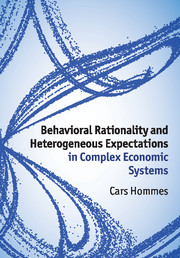Book contents
- Frontmatter
- Contents
- Figures
- Preface
- 1 Introduction
- 2 Bifurcations and chaos in 1-D systems
- 3 Bifurcations and strange attractors in 2-D systems
- 4 The nonlinear cobweb model
- 5 The cobweb model with heterogeneous expectations
- 6 An asset pricing model with heterogeneous beliefs
- 7 Empirical validation
- 8 Laboratory experiments
- Bibliography
- Index
4 - The nonlinear cobweb model
Published online by Cambridge University Press: 05 February 2013
- Frontmatter
- Contents
- Figures
- Preface
- 1 Introduction
- 2 Bifurcations and chaos in 1-D systems
- 3 Bifurcations and strange attractors in 2-D systems
- 4 The nonlinear cobweb model
- 5 The cobweb model with heterogeneous expectations
- 6 An asset pricing model with heterogeneous beliefs
- 7 Empirical validation
- 8 Laboratory experiments
- Bibliography
- Index
Summary
In this chapter we discuss price dynamics in nonlinear versions of the cobweb or the “hog cycle” model under homogeneous price expectations. The main purpose is to illustrate the role of expectations feedback and bounded rationality in a simple nonlinear economic environment. To keep the analysis as simple as possible, we will work with a linear demand curve, whereas the supply curve will be nonlinear, but monotonically increasing most of the time; in some examples the supply curve will be non-monotonic, backward-bending. We use the nonlinear cobweb model as a didactic tool, because it is one of the simplest dynamic models in economics. It has served as a benchmark model since its introduction in the 1930s and, in particular, it has served as a simple economic environment to discuss expectations feedback. For example, Ezekiel (1938) studied the cobweb model under naive expectations, Goodwin (1947) under linear trend-following and contrarian expectations rules and Nerlove (1958) under adaptive expectations. Muth (1961) used the cobweb framework in his seminal paper introducing rational expectations. In this chapter we study the nonlinear cobweb model with homogeneous expectations, i.e., all producers have the same price expectations. Our main purpose is to illustrate how simple but commonly used expectations rules and bounded rationality in a nonlinear environment may lead to irregular, possibly chaotic price fluctuations. In Chapter 5 we will consider the cobweb model with heterogeneous expectations.
The cobweb model
The classical cobweb model is a partial equilibrium model describing commodity price fluctuations of a non-storable good, such as corn or hogs, that takes one time period to produce. It is one of the simplest benchmark models in economic dynamics and can be found in many standard textbooks (e.g., Nicholson 1995, pp. 590–594). Producers form price expectations one period ahead and derive their optimal production decision from expected profit maximization.
- Type
- Chapter
- Information
- Publisher: Cambridge University PressPrint publication year: 2013



